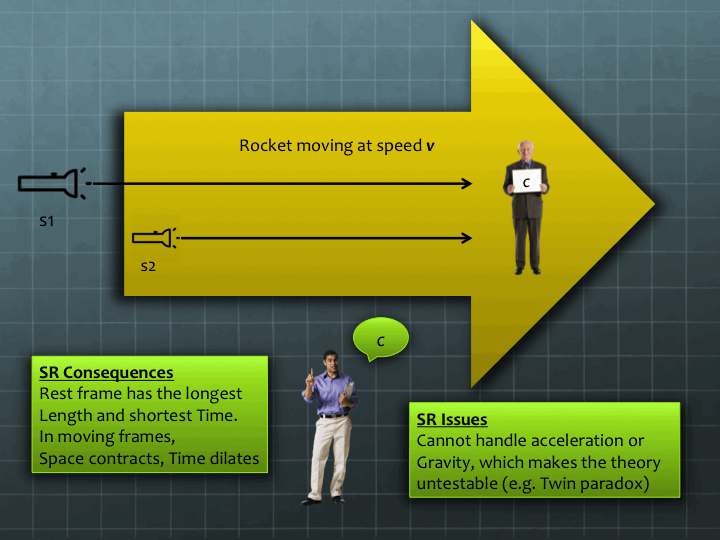The speed of light being a constant sounds like a simple statement. But there is more to it, quite a bit more. Let’s look at what this constancy really means. At first glance, it says that if you are standing somewhere, and there is a ray of light going from your right to left, it has a speed c. And another ray of light going from left to right also has a speed c. So far, so good. Now let’s say you are in a rocket ship, as shown in the figure below, moving from right to left.
The yellow arrow is the rocket ship moving at a constant speed of v, and you are the scientist standing in there measuring the speed of the light beam as it passes you. Even that simple statement is not without its complications. When I say your ship is moving, I have to say with respect to what. Let’s say the motion is with respect to the younger gentleman standing outside.
Let’s also say you are trying to measure the speed of the light coming from the source S1, which is outside your spaceship. You would naively expect to measure c-v, because you are moving away from it to your left. But no, you will get c. The same holds true if you measure the speed of the light coming from source S2, which is inside the spaceship, moving with you.
If you think these results are peculiar, you haven’t seen anything yet. Let’s say the younger fellow measures the speed of the same light beams. He would also get c! In order for this to happen, the space in the rocket is contracted (shrunk), and the time dilated.
The special theory of relativity is highly counter-intuitive (which is physics speech for nonsensical) because it is not as though the rocket is really moving. Remember, only relative motion has physical significance, which is the principle of relativity. For you, the scientist in the rocket, you are stationary, and it is the younger fellow outside who is moving in the opposite direction at a constant speed of v. So it is his space and time that are contracted and dilated. This is all very strange, but true. This is exactly the basis of the thought experiment they call the twin paradox.
Twin Pradox
In twin paradox, one of two twin brothers goes on an inter-galactic mission at a very high (close to c) speed, and returns. His time runs slow because of his state of motion, and when he reunites with his brother, the travelling twin will be much younger than other one.
But then, you could look at it from the travelling twin’s perspective. For him, it is the other twin, along with planet Earth, that is flying away at a high speed and coming back to join him. It is his time that is dilated, and he is the one who should be younger.
So who is going to be the younger one? This is the paradox.
The twin paradox is resolved once we realize that the travelling twin cannot make the journey without acceleration, and Special Relativity cannot be applied to accelerating (or the so-called non-inertial) frames. Since the travelling twin felt the motion because of acceleration and deceleration, he is the one who will be younger than the one that stayed back. The twin paradox is resolved using General Relativity, which can handle acceleration.



